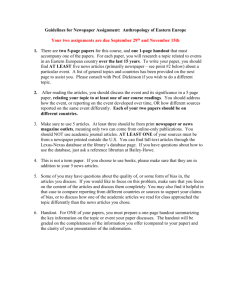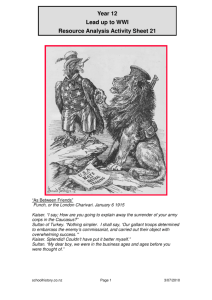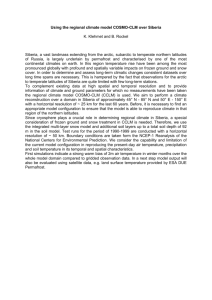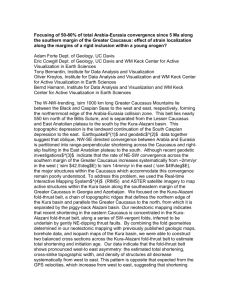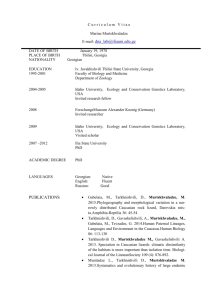Cent Asia - Life
advertisement
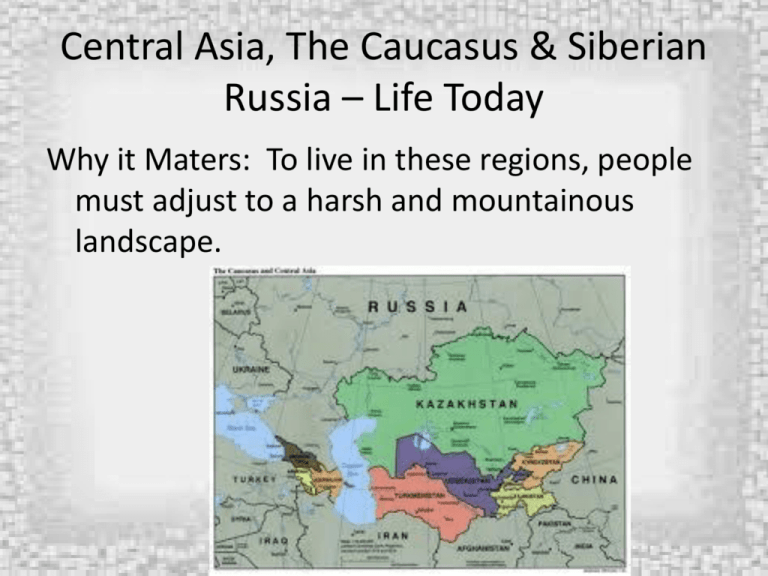
Central Asia, The Caucasus & Siberian Russia – Life Today Why it Maters: To live in these regions, people must adjust to a harsh and mountainous landscape. Questions you should be able to answer when we’re done: • Who are the peoples of Siberia, Central Asia, and the Caucasus and where do they live? • How are the cultures of Central Asia and the Caucasus alike and different? • What challenges lie ahead for the regions? Vocab: • Oasis • Homogenous • yurt From your text: Trading in Bukhara. Settlement Patters • Siberia and Central Asia – A few large cities, sparsely settled remote areas • Caucasus – More urban region, more dense population in urban areas Siberian Russia • Most people live in cities near the transSiberian railroad • Novosibirsk (1.5 million) is Siberia’s largest city. • Some small cities and towns along the major rivers – Ob’, Yenisey and Lena • Some cities on Siberia’s eastern coast – like Vladivostok Resettlement Programs • Programs of the Czars and Soviets have made Siberia’s population mostly Russian • There are still populations of Mongol and Turkic groups. Central Asia Kazakhstan • Kazakhstan – only central Asian country with a largely urban population. (60 %) • 2/3 ethnic Kazakhs • ¼ Russian Turkmenistan • • • • Turkmenistan – 50/50 urban and rural ¾ ethnic Turkomans 10% Russians Most Turkoman’s live in villages, Most Russians live in cities – like the capital Ashkabad. Uzbekistan • Most people live in the eastern ½ of the country. • 2/3 Rural • Oases are covered with Orchards, Fields and irrigation canals. • Most rural people are Uzbeks, Most city dwellers are Russian and Kazakh Kyrgyzstan • The people are Kirghiz – once nomads who were settled onto collectives during the Soviet Era. • Less than 40 percent urban. • Most city dwellers are Russian and Uzbeks. Tajikistan • Mostly rural • Mountainous terrain • Irrigation has created densely populated oases. • 80% ethnic Tajiks • The rest Uzbeks Tajikistan • Contains the Fedchenko Glacier – it is more than 40 miles long and one of the largest Alpine glaciers in the world. • Language is related to FARSI – the languge of Iran. The Caucasus • Armenia – almost ALL ethnic Armenian • Azerbaijan – mostly ethnic Azeri. • Georgia – large group of ethnic Georgians, but significant minority groups – mostly Armenian and Azeri • The Caucasus also has 50 smaller ethnic groups. The Caucasus • About 50/50 Urban / Rural • Armenia is more Urban. • Rural population is NOT evenly distributed. People and Cultures • Russian Influence – Strong in Central Asia – Only strong is parts of the Caucasus • Siberia – Russian language, Christianity (Russian Orthodox) • Buddhist and Muslim minorities. • Central Asia – Russian Language in addition to the ethnic majority language. Mix of Muslim and Christians depending on the country. • Caucasus – Armenians and Georgians – Christian – Azerbaijanis - Muslim Ethnic Unrest • Armenians vs. Turks and Azeris – Armenians were massacred in the 1890’s and during WWI • Armenian Christians vs Islamic Axeris in the Caucasus and Iran • Modern conflict: Armenians vs. Azeris over a region with an Armenian majority that is part of Azerbaijan. Georgia’s unrest • Armenian minority has sought greater self rule. • 1992 Abkhaz and Ossentians have revolted for independence. Tajikistan • Civil war after Soviet Rule ended. Daily Life - Stans • Urban – European Dress • Rural – Traditional Dress – Yurts – Equestrian sports important to the culture of the nomadic people Yurt Relationships and Challenges • Since the Soviet era, most Caucasus and Central Asian Countries have struggled to establish stable, democratic governments and free-enterprise economies. Even though most countries adopted new constitutions with democratic governments, it was hard to get them in place • Russians have been leaving Central Asia gradually since the end of Soviet Rule. – At first “Brain Drain”, but now the new graduates are filling the gap. Soviet Legacy Pollution and Environmental disregard – also leading to health issues. Territorial Issues • Border issues with most countries since the Soviet Union did not create borders that paid attention to ethnic boundaries • Territory disputes over land that has resources – ex: seabed of the Caspian Sea • Russia vs Japan regarding the Kuril Islands south of Siberia’s Kamchatka Some Charts to help…… Where do people live? • • • • • • • Siberia Kazakhstan Turkmenistan Uzbekistan Kyrgyzstan Tajikistan Caucasus • • • • • • • Near the Rail 60% Urban 40% Rural 505 urban 50% Rural 66% Rural 60% Rural Mostly Rural Up to 70% Urban Ethnicity • • • • Turkmenistan Kazakhstan Uzbekistan Kyrgyzstan • Tajikistan • • • • 75% Turkoman 10% Russian 66% Kazakh 25% Russian Uzbeks, Russians, Kazakhs 66 % Kirghiz, the rest Uzbek & Russian • 80% Tajik, the rest Uzbek Religion • Siberia • • • • • Kazakhstan Armenia Azerbaijan Georgia The Rest of Central Asia • Russian Orthodox Christian (Buddhist & Muslim minorities.) • 50% Christian 50% Muslim • Mostly Christian • Mostly Muslim • Mostly Christian (sig. Muslim Minority) • 75 – 95% Muslim (Christian minority) Question 1 True or False: Turkmenistan is the only Central Asian country that is mostly urban. Question 2 True or False: Two-thirds of Kyrgyzstan's people are ethnic Russians Question 3 True or False: Russian is widely spoken throughout Central Asia Question 4 True or False: The countries of the Caucasus made a smooth transition to democracy. Question 5 True or False: Russia and Japan both claim ownership of parts of the Kuril Islands Question 6 How do settlement patterns in the Caucasus differ from those in Siberia and most of Central Asia? A) The Caucasus is a more urban region than Siberia or Central Asia. B) Unlike in Siberia and Central Asia, most people in the Caucasus live on farms. C) The rural areas of Siberia and Central Asia are more densely populated than those of the Caucasus. D) Unlike Siberia and Central Asia, the Caucasus has no large cities. Question 7 Most cities and towns in Siberia are located along or near which feature? A) B) C) D) Siberia’s eastern coast The Yenisey River The route of the Trans-Siberian Railroad The Ob’ and Lena rivers. Question 8 Where is Azerbaijan’s most densely populated area? A) In the extreme southeast between the Caspian Sea and the Iranian border. B) On the Ararat plain, near the Turkish border C) Around its capital city, Baku D) In the area along the Black Sea Coast. Question 9 Which of the following has been a source of unrest in Georgia? A) Christians in Georgia have demanded the right to practice their religion freely. B) Ethnic minority groups in Georgia have south independence and self rule. C) Income inequality be3tween rural Muslims and Urban Christians has led to rioting D) Georgian Communists backed by Russian troops, have fought Islamic groups. Question 10 Which of the following activities is important in most Central Asian cultures? A) raising and racing horses B) Breakdancing C) Growing flowers D) Sculpting statues from ice Question 11 Why is there such a mix of ethnicities in Siberian Russia? Question 12 How did Islam come to the countries of the Kazakhstan and Azerbaijan? Question 13 What is a yurt? Question 14 Why were the Caucasus and Central Asia slow to establish democratic governments when the Soviet Union collapsed? Vocab: • Oasis • Homogenous • yurt So……. • Who are the peoples of Siberia, Central Asia, and the Caucasus and where do they live? • How are the cultures of Central Asia and the Caucasus alike and different? • What challenges lie ahead for the regions? The End …”Borat from Kazakhstan”
